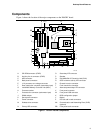
Desktop Board Features
15
Accelerated Graphics Port (AGP)
✏
NOTE
The D845HV and D845WN boards are only compatible with 1.5 V AGP cards.
AGP is a high-performance interface for graphics-intensive applications, such as 3D graphics.
AGP is independent of the PCI bus and is intended for exclusive use with graphical
display devices.
The AGP connector supports 1.5 V AGP 4X and 2X add-in cards. The AGP card retention
mechanism is used only with cards with retention notches (see Figure 12 on page 32). For
information about installing the AGP card retention mechanism and an AGP card,
see Chapter 2 on page 21.
Communication and Networking Riser (CNR) (Optional)
The optional CNR provides an interface that supports various features such as audio, modem,
USB, and LAN.
Audio Subsystem
The audio subsystem features the following:
• Intel 82801BA ICH2
• Analog Devices AD1885 analog codec (AC ’97)
✏
NOTE
The line out connector, located on the back panel, is designed to power either headphones or
amplified speakers only. Poor audio quality may occur if passive (non-amplified) speakers are
connected to this output.
Audio drivers and utilities are available from Intel’s World Wide Web site:
http://support.intel.com/support/motherboards/desktop/
BIOS
The BIOS provides the Power-On Self-Test (POST), the BIOS Setup program, the PCI and IDE
auto-configuration utilities, and the video BIOS. The BIOS is stored in the Firmware Hub.
The BIOS can be updated by following the instructions in Chapter 3 on page 43.
PCI Auto Configuration
If you install a PCI add-in card in your computer, the PCI auto-configuration utility in the BIOS
automatically detects and configures the resources (IRQs, DMA channels, and I/O space) for that
add-in card. You do not need to run the BIOS Setup program after you install a PCI add-in card.


















